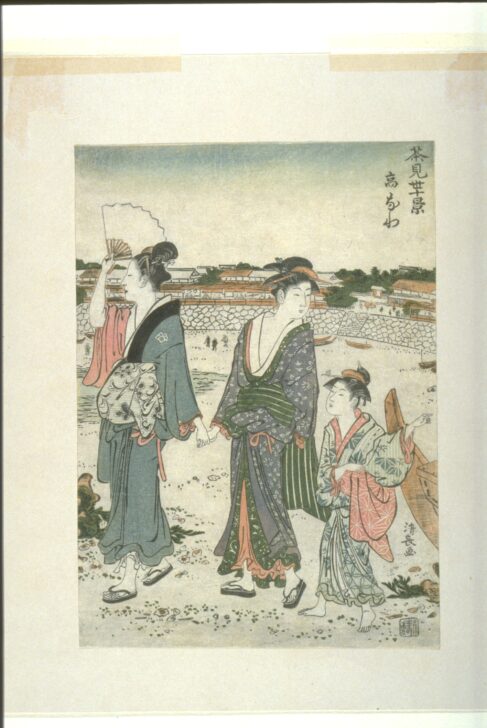Views of Ten Tea Houses: Takanawa
Torii Kiyonaga

Description
Gallery Rotation Fall 2013
Torii Kiyonaga
Japan, 1752–1815
Views of Ten Tea Houses: Takanawa
Edo period (1615–1868)
circa 1783
Color woodblock print on paper
Museum purchase, 1960/1.143
Subject Matter:
Outside of the licensed pleasure quarter of Yoshiwara, there were several unlicensed brothel districts in Edo. When Yoshiwara was devastated by a fire in the 1780s, these heretofore disreputable areas were spruced up and briefly became the major entertainment attractions in town. Few artists capture the déclassé atmosphere of these environs as well as Torii Kiyonaga.
In this print, one of a series of ten views of "tea house" districts, he has depicted two women and a child strolling along the shore by the sea wall at Takanawa. Kiyonaga carefully delineates their class and age: the woman at left is the eldest and clearly in charge; that she ties her obi in front identifies her as a prostitute. Her younger companion must be in the same profession, judging from the way she allows her kimono to fall wide open. The child may be a daughter of the first woman, or a young apprentice. Yet for all of his straightforward rendering of these women as lower-class, there is no hint of disdain or tawdry seaminess in Kiyonaga’s image.
This is an especially well-preserved print, where even the indigo blue is still visible. The colors used in Japanese prints throughout the eighteenth century were made from plants, and very "fugitive"—that is, they quickly fade when exposed to light. In the great majority of prints, what had once been a rich palette of purples, pinks, and blues has faded to pale browns and grays.
Physical Description:
In this print, one of a series of ten views of "tea house" districts, Kiyonaga has depicted two women and a child strolling along the shore by the sea wall at Takanawa. A woman at left shields her eyes from the summer sun with her fan, and has her obi tied in front of her. The younger looking companion holding her hand wears a gaily flowered kimono, which has fallen wide open. A child walks with them, gesturing to the side of the print. The front portion of a boat and wall of a town or temple lie behind them.
This is an especially well-preserved print, where even the indigo blue is still visible.
Usage Rights:
If you are interested in using an image for a publication, please visit https://umma.umich.edu/request-image/ for more information and to fill out the online Image Rights and Reproductions Request Form.